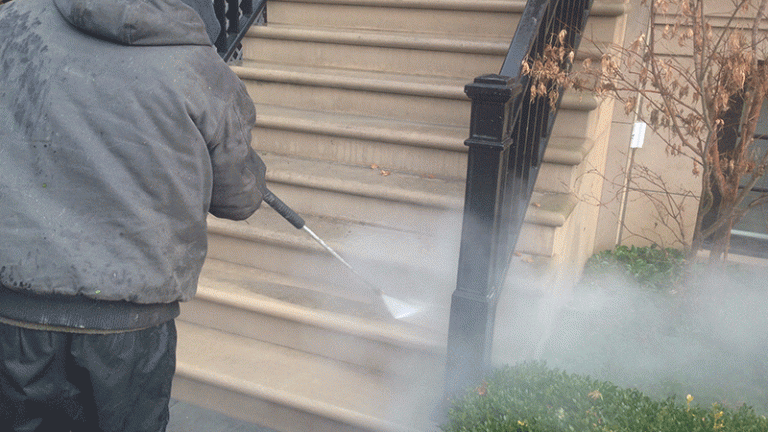
Over time, any building material accumulates dirt and grime from the atmosphere. In general, the more dirt in the air, the more dirt the building will accumulate. And dirt and fly ash, city grime and suburban dust are the culprits, rather than acid rain. Atmospheric pollution, in the form of acid rain or other chemical elements, is not a factor in either the structural or aesthetic performance of Indiana Limestone. (See ILI Technote on Durability.) Natural wash patterns are often seen on older buildings. In limestone construction, the lighter colors will usually be closer to the stone's original hues. And those natural colors can quite often be revealed by thoughtful cleaning methods, even after the passage of many years.
There are three categories of methods or procedures recognized for cleaning masonry and stone buildings:
The "Wet" methods include misting, in which a pierced hose is so placed as to allow water to run gently over the surface for protracted periods of time; washing with hand-held hoses at pressures ranging from normal city pressure up to 1,200 pounds per square inch, and steam (hot water at relatively low pressure). One hybrid method combines relatively low-pressure water with sand or other abrasive discharged from a nozzle with multiple hoses and ports. The sand is said to be "cushioned" by the water. Wet methods are often augmented by the application of soap or detergent.
The "Dry" methods include sandblast and grinding. Sandblast can produce startling results by removing layers of stone as well as dirt. The same is true for grinding or hand-held sandpaper. The "dry" methods are considered excessive by most conservationists because of their potential for damage. In some instances, sandblast or grinding may be required.
"Chemical" methods include the application of ordinary muriatic and other acids in various dilutions. Caustic materials are also used for this purpose. Proprietary products tend to be acidic; many include detergents and surfactants which are said to lessen the damage potential inherent in acids and caustics.
Depending on the complexity of the stonework to be cleaned, the degree and type of soil to be removed, and the predetermination about an acceptable degree of cleanness, no single method may be satisfactory, and experimentation may be required. But as a general rule, ILI prefers the high-pressure water method. Water from a pressure rig at no pressure higher than 1,200 p.s.i., from a 45 fan-shaped nozzle held no closer than 6" to the face of the stone will usually produce acceptable results.
ILI recommends that architects and their clients decide in advance how clean the building must be, keeping in mind that the dirt is not harmful, and that its complete eradication almost always removes remaining original surface and increases surface area. If 80% to 90% clean is the target, the relatively benign high-pressure and/or steam method described above will perform satisfactorily in nearly every case. Note, however, that even high-pressure water can cause damage. Pressure, nozzle size and working distance are all controlled by the operator and can be abused.
One type of accumulation on limestone, marble, concrete and other calcareous materials is algae. At arm's length, this material appears to be simply a collection of dirt that is affected by water flow over the surface. Under magnification, tiny spots of red, green and orange appear as the algal flowers. This material can be removed by hydrogen peroxide scrubbed on full strength over wetted stone. After agitation, loosened algae can be hosed away without harm to the stone surfaces.
A good practice when major cleaning is contemplated is to invite operators to clean a sample area using their preferred method. This procedure will reveal much about the operator, his workers and his equipment, the amount of disruption likely in his procedure, all in addition to how well his procedure works, and how much damage is done. A cleaned area can be used as the target sample for bidders and as the comparative area for punch-list.
All Information provided comes directly from the Indiana Limestone Institute (ILI)

